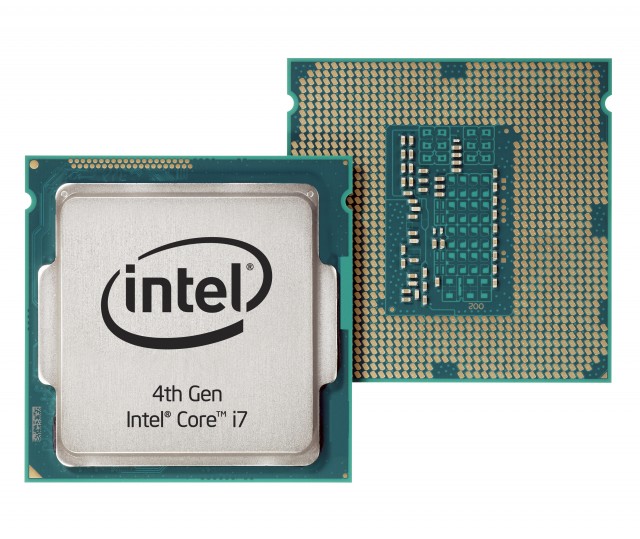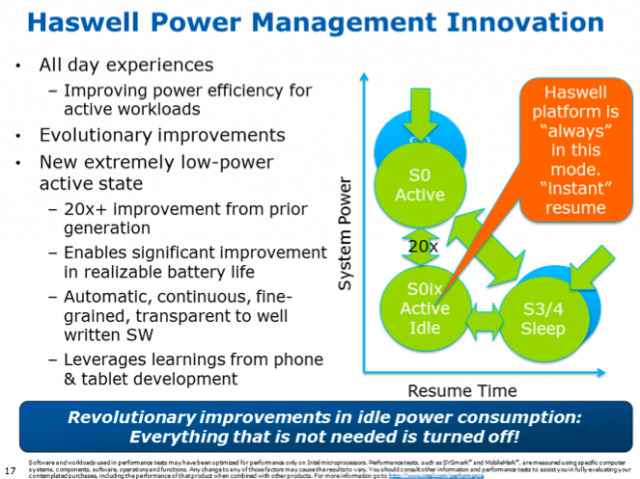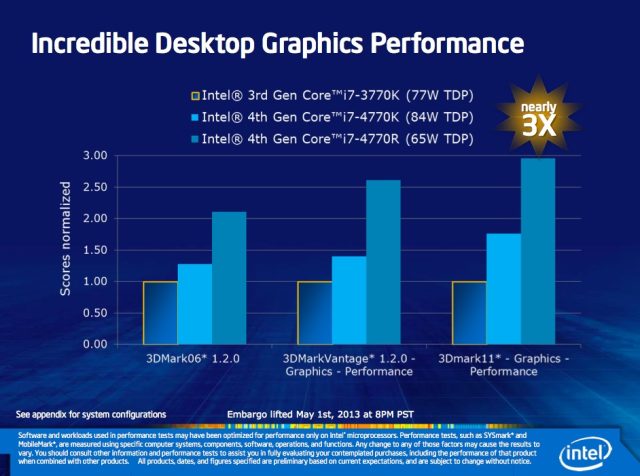
Intel has been releasing information about Haswell, its next-generation CPU architecture, for months now. Our coverage has already been fairly extensive—we've already got a nice overview of Haswell's CPU architecture itself, along with a primer on its brand-new integrated GPUs. All we need to know now is specific product information, and Intel is finally giving us our first official taste of that today.
This morning's announcements revolve around high-end quad-core chips in the Core i7 and Core i5 families, 12 for desktops and 10 for laptops. If you're looking for specific information about U- and Y- series low-voltage chips for Ultrabooks or anything belonging to the Core i3, Pentium, or Celeron families, you'll have to wait a little while longer. We'll be sure to pass that information along as we have it.
What we'll do here is present a high-level recap of the CPU, GPU, and chipset enhancements Intel is introducing in Haswell. After that, we'll break down the specific CPUs that Intel is announcing today and the kinds of systems you're likely to find them in. Note that all of this information is coming directly from Intel—they're not going to out-and-out make things up, but they're definitely going to present their CPUs in the best possible light. We'll be putting all of the below performance claims to the test as we begin to review Haswell-based systems later this summer.
The CPUs: Performance is up a little, power consumption is down a lot
The biggest part of the fourth-generation Core launch is Haswell itself, the new CPU architecture that supersedes last year's Ivy Bridge (which was itself only a modification of 2011's Sandy Bridge). Haswell is a "tock" in Intel's overarching "tick-tock" refresh strategy, meaning that it is a new architecture built on Intel's established 22nm 3D tri-gate manufacturing process. Next year's refresh, code-named Broadwell, will modify the Haswell architecture for manufacture on Intel's forthcoming 14nm process.
David Kanter has already done a deep dive into the particulars of Haswell's architecture, and we won't attempt to duplicate his explanation and analysis here. Like previous architectures, Haswell should increase performance relative to Ivy Bridge while consuming similar or lower levels of power.
This time around, Intel is actually much more interested in telling us about that lowered power consumption, as is evident in the use of phrases like "biggest [generation-to-generation] battery life increase in Intel history." By the company's measurements, a laptop based on Haswell should in some circumstances be able to get as much as a third more battery life than the same laptop based on Ivy Bridge. We'll need to wait for actual systems to bear that supposition out, though. It's entirely possible that OEMs will choose to keep battery life level while reducing the size of the battery (and thus, their devices' weight and thickness) or adding other power-hungry features like high-resolution displays.
Some of these power savings come because Haswell is the first architecture tailored specifically for the 22nm process rather than being designed for a larger process and then shrunk down, as Ivy Bridge was. Others come from improvements that Intel has made it to idle power usage and the amount of power used when switching between those active and idle states. A new "active idle" power state, also dubbed S0ix, allows the system to continue sending and receiving data without powering the CPU and GPU all the way up. This increases the amount the system can do without being "active" and reduces the amount of power needed to switch to a fully active state.

A side effect of Haswell's low-power leanings is that the architecture will find itself in more form factors than ever, from workstations and servers at the top end to Ultrabooks, convertibles, and tablets at the low end. There will even be some overlap with Atom processors, as we've already seen in some Ivy Bridge-based Windows 8 tablets. That area of overlap will only get larger as Atom continues to get faster (see: Bay Trail, due later this year).
Intel has been pushing Ultrabooks and convertibles hard through the life of the Sandy Bridge and Ivy Bridge architectures and expect that push to continue with Haswell—a source at Intel even told Ars that Haswell-powered Android tablets and laptops are in the cards as the company refines its Android strategy.
Of course, most of this information applies to dual-core, Ultrabook-ready CPUs that haven't yet been announced. Given that Ultrabooks and low-power CPUs are a large and growing piece of Intel's pie, we doubt we'll make it past Computex without those CPUs making an appearance as well.
The GPUs: More power, more choices, more potential for confusion

Intel has improved its integrated GPUs by leaps and bounds in the past two years, and Haswell will continue that trend. With this increased power comes increased complexity, though: there are now at least five separate integrated GPUs that will come with Haswell CPUs, up from three in Ivy Bridge.
We've covered all five products in more detail here, but all of them should support the same basic features: Direct3D 11.1, OpenCL 1.2, and OpenGL 4.1 on the API side; DisplayPort 1.2, which should improve support for 4K resolutions; and a faster version of Intel's QuickSync video encoding engine are all among the highlights.
Intel's new "Iris" GPUs are the ones we'll probably hear the most about, though as we'll see in a bit they're certainly not the ones that will ship in the majority of its chips. The Iris 5100 will roughly double the performance of the Intel HD 4000 GPU in most cases, but it will be confined mostly to performance notebooks and larger Ultrabooks because of its 28 watt TDP (ultra-low-voltage Haswell Ultrabook chips will generally have TDPs of 15 watts or less). The Iris Pro 5200 GPU adds 128MB of eDRAM directly to the processor die to boost performance even further—about 2.5 times the Intel HD 4000 in laptops, according to Intel—but those CPUs' even-higher TDP of 47 watts will confine them to larger notebooks. In desktops, the sole announced CPU with the Iris Pro 5200 delivers almost three times better performance than the HD 4000 by Intel's metrics, likely due to the increased thermal headroom available in a desktop's chassis.
The other GPUs, which retain the Intel HD Graphics branding, are less glamorous but remain a reasonable upgrade over the Intel HD 4000. Intel's slides all seem to suggest that the HD 5000 and the HD 4600 GPUs both deliver performance roughly 1.5 times better than the HD 4000. The difference is that the HD 5000 part is destined for as-yet-unannounced 15 watt TDP Ultrabook parts, while the HD 4600 is the mainstream GPU you'll find paired with most of the CPUs being launched today. The differences between the HD 4600, 4400, and 4200, aren't immediately apparent using the information Intel is providing, but we'd guess that the difference may be in features and perhaps maximum clock speeds rather than raw 3D execution resources.

Finally, there's the lowly Intel HD Graphics at the bottom of the slide, about which we know very little. If past is prologue, this will be a basic GPU with most of the extra features (QuickSync, for instance) disabled, and it will ship only in Haswell-based Pentium and Celeron processors. Typically, new architectures don't trickle down into entry-level CPUs until a few months after their introduction, and we expect that to remain true for Haswell.
reader comments
168